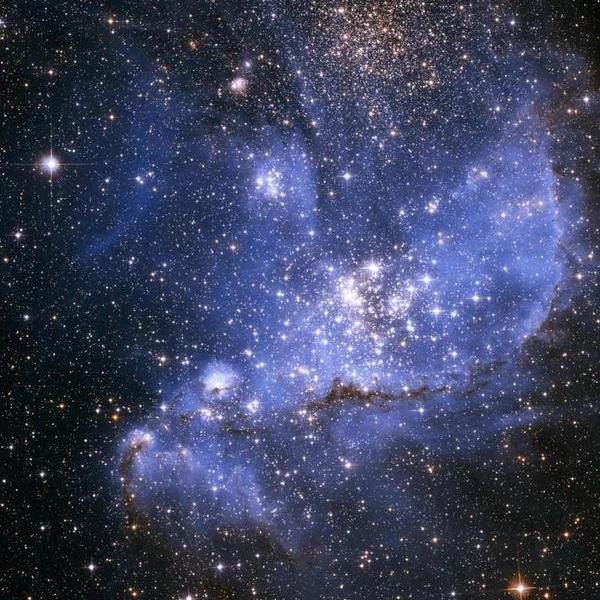
The NGC 346 is one of the most active H II regions in the Small Magellanic Cloud, a small satellite of the Milky Way visible from the Southern Hemisphere. This nebula shines with its massive young stars and gas filaments, making it a natural laboratory for understanding how stars are born in environments poor in heavy elements, known as low metallicity.
N.B.:
An H II region is a cloud of gas primarily composed of ionized hydrogen. It forms when ultraviolet light from young, very hot stars strips electrons from surrounding hydrogen atoms. These regions are the "cradles" of stars and appear bright in optical and UV observations. The density and temperature of the gas in an H II region strongly influence star formation and the structure of the nebula.
NGC 346 exhibits a fascinating structure, blending ionized gas filaments, bubbles blown by stellar winds, and clusters of very young stars. Images captured in ultraviolet and optical light reveal extremely bright areas, indicating the presence of massive stars that heat and ionize the surrounding gas. These interactions sculpt the nebula, creating varied and dynamic shapes.
The gas filaments are oriented by the stellar wind produced by massive stars and the remnants of ancient supernovae. Young stars cluster in compact groups, suggesting that star formation occurs in localized episodes. This process resembles a cosmic firework, where each star explosion or wind triggers the birth of new stars nearby.
The nebula is primarily composed of ionized hydrogen (H II), but it also contains traces of helium, oxygen, and neon. Spectroscopic analyses show that the abundances of these elements are slightly lower than those observed in the Milky Way. This unique composition allows astronomers to study star formation in a context similar to that of the primordial universe.
To study NGC 346, astronomers use the Hubble Space Telescope and ground-based telescopes equipped with spectrographs and cameras sensitive to different wavelengths. These observations allow measuring gas density, temperature, and the speed of ionized flows. They also provide valuable information about young star populations, their mass, and distribution within the nebula.
In the H II regions of NGC 346, gas density typically ranges from 100 to 1000 particles per cubic centimeter, which is very rarefied compared to the air we breathe. The gas temperature reaches between 10,000 and 12,000 K, high enough to ionize hydrogen and produce the nebula's characteristic light. These extreme conditions favor the rapid formation of massive stars, as hot, ionized gas can collapse locally under gravity to create new suns.
| Parameter | Estimated Value | Observation Method | Comment |
|---|---|---|---|
| Distance | ~210,000 light-years | Parallax and Cepheids | Located in the Small Magellanic Cloud |
| Diameter | ~200 light-years | Optical and IR Imaging | Includes filaments and star clusters |
| Gas Temperature | 10,000 - 12,000 K | Spectroscopy | Highly ionized H II regions |
| Gas Density | 100 - 1,000 particles/cm³ | Spectroscopy and Models | Average density of ionized gas |
| Stellar Populations | Several thousand young stars | Photometry and Imaging | Massive stars and young clusters |
Source: Massey et al., 2002, Astronomical Journal and Hubble Space Telescope